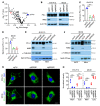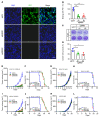PD-L1 translocation to the plasma membrane enables tumor immune evasion through MIB2 ubiquitination
- PMID: 36719382
- PMCID: PMC9888393
- DOI: 10.1172/JCI160456
PD-L1 translocation to the plasma membrane enables tumor immune evasion through MIB2 ubiquitination
Abstract
Programmed death-ligand 1 (PD-L1), a critical immune checkpoint ligand, is a transmembrane protein synthesized in the endoplasmic reticulum of tumor cells and transported to the plasma membrane to interact with programmed death 1 (PD-1) expressed on T cell surface. This interaction delivers coinhibitory signals to T cells, thereby suppressing their function and allowing evasion of antitumor immunity. Most companion or complementary diagnostic devices for assessing PD-L1 expression levels in tumor cells used in the clinic or in clinical trials require membranous staining. However, the mechanism driving PD-L1 translocation to the plasma membrane after de novo synthesis is poorly understood. Herein, we showed that mind bomb homolog 2 (MIB2) is required for PD-L1 transportation from the trans-Golgi network (TGN) to the plasma membrane of cancer cells. MIB2 deficiency led to fewer PD-L1 proteins on the tumor cell surface and promoted antitumor immunity in mice. Mechanistically, MIB2 catalyzed nonproteolytic K63-linked ubiquitination of PD-L1, facilitating PD-L1 trafficking through Ras-associated binding 8-mediated (RAB8-mediated) exocytosis from the TGN to the plasma membrane, where it bound PD-1 extrinsically to prevent tumor cell killing by T cells. Our findings demonstrate that nonproteolytic ubiquitination of PD-L1 by MIB2 is required for its transportation to the plasma membrane and tumor cell immune evasion.
Keywords: Cancer; Cancer immunotherapy; Cell Biology; Cellular immune response; Oncology.
Figures








Similar articles
-
ANXA1-derived peptide for targeting PD-L1 degradation inhibits tumor immune evasion in multiple cancers.J Immunother Cancer. 2023 Mar;11(3):e006345. doi: 10.1136/jitc-2022-006345. J Immunother Cancer. 2023. PMID: 37001908 Free PMC article.
-
Overexpression of DAPK1-mediated inhibition of IKKβ/CSN5/PD-L1 axis enhances natural killer cell killing ability and inhibits tumor immune evasion in gastric cancer.Cell Immunol. 2022 Feb;372:104469. doi: 10.1016/j.cellimm.2021.104469. Epub 2021 Dec 10. Cell Immunol. 2022. PMID: 35114597
-
Protein O-fucosyltransferase 1 promotes PD-L1 stability to drive immune evasion and directs liver cancer to immunotherapy.J Immunother Cancer. 2024 Jun 21;12(6):e008917. doi: 10.1136/jitc-2024-008917. J Immunother Cancer. 2024. PMID: 38908854 Free PMC article.
-
Emerging Role of Ubiquitination in the Regulation of PD-1/PD-L1 in Cancer Immunotherapy.Mol Ther. 2021 Mar 3;29(3):908-919. doi: 10.1016/j.ymthe.2020.12.032. Epub 2021 Jan 1. Mol Ther. 2021. PMID: 33388422 Free PMC article. Review.
-
PD-1/PD-L1 immune checkpoint: Potential target for cancer therapy.J Cell Physiol. 2019 Feb;234(2):1313-1325. doi: 10.1002/jcp.27172. Epub 2018 Sep 7. J Cell Physiol. 2019. PMID: 30191996 Review.
Cited by
-
Resetting the Hsc70-mediated lysosomal degradation of PD-L1 via a supramolecular meso peptide for the restoration of acquired anti-tumor T cell immunity.J Nanobiotechnology. 2025 Feb 4;23(1):79. doi: 10.1186/s12951-025-03171-x. J Nanobiotechnology. 2025. PMID: 39905428 Free PMC article.
-
CDK5 destabilizes PD-L1 via chaperon-mediated autophagy to control cancer immune surveillance in hepatocellular carcinoma.J Immunother Cancer. 2023 Nov 24;11(11):e007529. doi: 10.1136/jitc-2023-007529. J Immunother Cancer. 2023. PMID: 38007240 Free PMC article.
-
p53/PD-L1 co-expression predicts poor prognosis in diffuse large B-cell lymphoma.Discov Oncol. 2025 Jul 6;16(1):1270. doi: 10.1007/s12672-025-03062-5. Discov Oncol. 2025. PMID: 40618312 Free PMC article.
-
Isobutyric Acid Promotes Immune Evasion in Colorectal Cancer via Increased PD-L1 Expression.Cancer Med. 2024 Nov;13(21):e70397. doi: 10.1002/cam4.70397. Cancer Med. 2024. PMID: 39503247 Free PMC article.
-
Demethylzeylasteral induces PD-L1 ubiquitin-proteasome degradation and promotes antitumor immunity via targeting USP22.Acta Pharm Sin B. 2024 Oct;14(10):4312-4328. doi: 10.1016/j.apsb.2024.08.004. Epub 2024 Aug 8. Acta Pharm Sin B. 2024. PMID: 39525573 Free PMC article.
References
Publication types
MeSH terms
Substances
Grants and funding
LinkOut - more resources
Full Text Sources
Molecular Biology Databases
Research Materials
Miscellaneous

